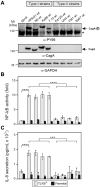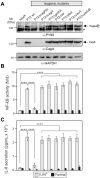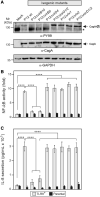Unique TLR9 Activation by Helicobacter pylori Depends on the cag T4SS, But Not on VirD2 Relaxases or VirD4 Coupling Proteins
- PMID: 35239059
- PMCID: PMC8894178
- DOI: 10.1007/s00284-022-02813-9
Unique TLR9 Activation by Helicobacter pylori Depends on the cag T4SS, But Not on VirD2 Relaxases or VirD4 Coupling Proteins
Abstract
The genomes of the gastric bacterial pathogen Helicobacter pylori harbor multiple type-IV secretion systems (T4SSs). Here we analyzed components of three T4SSs, the cytotoxin-associated genes (cag) T4SS, TFS3 and TFS4. The cag T4SS delivers the effector protein CagA and the LPS-metabolite ADP-heptose into gastric epithelial cells, which plays a pivotal role in chronic infection and development of gastric disease. In addition, the cag T4SS was reported to facilitate conjugative transport of chromosomal bacterial DNA into the host cell cytoplasm, where injected DNA activates intracellular toll-like receptor 9 (TLR9) and triggers anti-inflammatory signaling. Canonical DNA-delivering T4SSs in a variety of bacteria are composed of 11 VirB proteins (VirB1-11) which assemble and engage VirD2 relaxase and VirD4 coupling proteins that mediate DNA processing and guiding of the covalently bound DNA through the T4SS channel. Nevertheless, the role of the latter components in H. pylori is unclear. Here, we utilized isogenic knockout mutants of various virB (virB9 and virB10, corresponding to cagX and cagY), virD2 (rlx1 and rlx2), virD4 (cag5, traG1/2) and xerD recombinase genes in H. pylori laboratory strain P12 and studied their role in TLR9 activation by reporter assays. While inactivation of the structural cag T4SS genes cagX and cagY abolished TLR9 activation, the deletion of rlx1, rlx2, cag5, traG or xerD genes had no effect. The latter mutants activated TLR9 similar to wild-type bacteria, suggesting the presence of a unique non-canonical T4SS-dependent mechanism of TLR9 stimulation by H. pylori that is not mediated by VirD2, VirD4 and XerD proteins. These findings were confirmed by the analysis of TLR9 activation by H. pylori strains of worldwide origin that possess different sets of T4SS genes. The exact mechanism of TLR9 activation should be explored in future studies.
© 2022. The Author(s).
Conflict of interest statement
The authors have no conflict of interest to declare.
Figures




References
-
- Sung H, Ferlay J, Siegel RL, Laversanne M, Soerjomataram I, Jemal A, Bray F. Global cancer statistics 2020: GLOBOCAN estimates of incidence and mortality worldwide for 36 cancers in 185 countries. CA Cancer J Clin. 2021;71:209–249. - PubMed
-
- Rudnicka K, Backert S, Chmiela M. Genetic polymorphisms in inflammatory and other regulators in gastric cancer: risks and clinical consequences. Curr Top Microbiol Immunol. 2019;421:53–76. - PubMed
-
- Linz B, Balloux F, Moodley Y, Manica A, Liu H, Roumagnac P, Falush D, Stamer C, Prugnolle F, van der Merwe SW, Yamaoka Y, Graham DY, Perez-Trallero E, Wadstrom T, Suerbaum S, Achtman M. An African origin for the intimate association between humans and Helicobacter pylori. Nature. 2007;445:915–918. - PMC - PubMed
MeSH terms
Substances
Grants and funding
LinkOut - more resources
Full Text Sources
Medical

